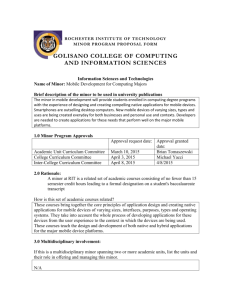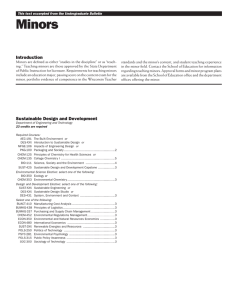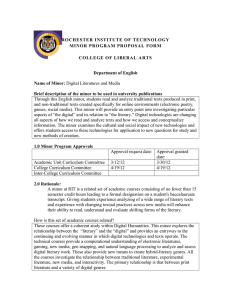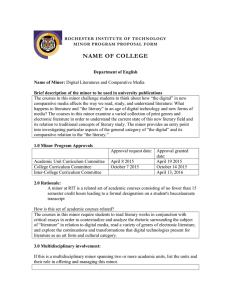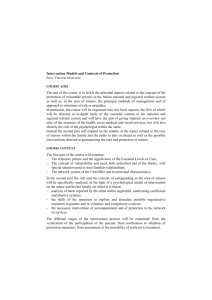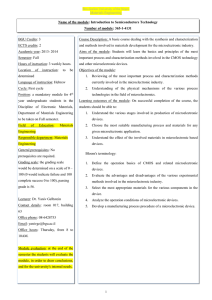Microelectronic Engineering
advertisement
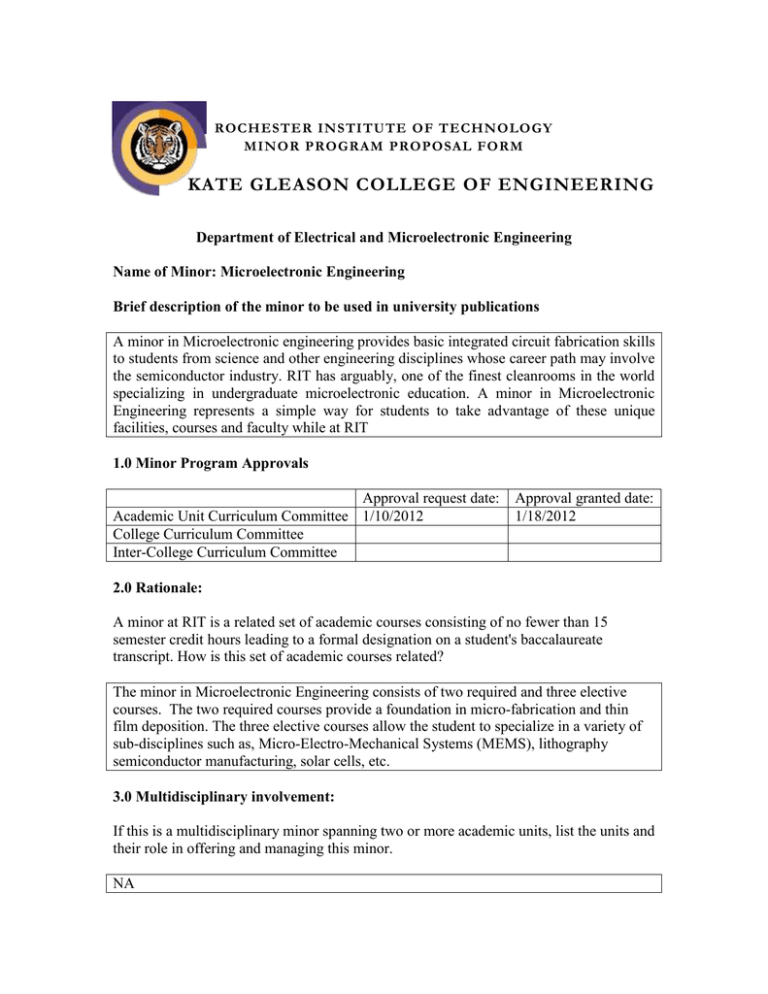
ROCHESTER INSTITUTE OF TECHNOLOGY MINOR PROGRAM PROPOSAL FORM KATE GLEASON COLLEGE OF ENGINEERING Department of Electrical and Microelectronic Engineering Name of Minor: Microelectronic Engineering Brief description of the minor to be used in university publications A minor in Microelectronic engineering provides basic integrated circuit fabrication skills to students from science and other engineering disciplines whose career path may involve the semiconductor industry. RIT has arguably, one of the finest cleanrooms in the world specializing in undergraduate microelectronic education. A minor in Microelectronic Engineering represents a simple way for students to take advantage of these unique facilities, courses and faculty while at RIT 1.0 Minor Program Approvals Approval request date: Academic Unit Curriculum Committee 1/10/2012 College Curriculum Committee Inter-College Curriculum Committee Approval granted date: 1/18/2012 2.0 Rationale: A minor at RIT is a related set of academic courses consisting of no fewer than 15 semester credit hours leading to a formal designation on a student's baccalaureate transcript. How is this set of academic courses related? The minor in Microelectronic Engineering consists of two required and three elective courses. The two required courses provide a foundation in micro-fabrication and thin film deposition. The three elective courses allow the student to specialize in a variety of sub-disciplines such as, Micro-Electro-Mechanical Systems (MEMS), lithography semiconductor manufacturing, solar cells, etc. 3.0 Multidisciplinary involvement: If this is a multidisciplinary minor spanning two or more academic units, list the units and their role in offering and managing this minor. NA 4.0 Students ineligible to pursue this minor: The purpose of the minor is both to broaden a student's college education and deepen it in an area outside the student’s major program. A minor may be related to and complement a student’s major, or it may be in a completely different academic/professional area. It is the responsibility of the academic unit proposing a minor and the unit’s curriculum committee to indicate any home programs for which the minor is not a broadening experience. Please list below any home programs whose students will not be allowed to pursue this minor, provide the reasoning, and indicate if this exclusion has been discussed with the affected programs: Microelectronic Engineering BS students (MCEE code) may not pursue this minor since it is their home department. There are no restrictions on any other majors, provided the student meets the required prerequisites. 5.0 Minor Program Structure, Sequence and Course Offering Schedule: Describe the structure of the proposed minor and list all courses, their anticipated offering schedule, and any prerequisites. All minors must contain at least fifteen semester credit hours; Minors may be discipline-based or interdisciplinary; In most cases, minors shall consist of a minimum of two upper division courses (300 or above) to provide reasonable breadth and depth within the minor; As per New York State requirements, courses within the minor must be offered with sufficient frequency to allow students to complete the minor within the same time frame allowed for the completion of the baccalaureate degree; Provide a program mask showing how students will complete the minor. Narrative of Minor Program Structure: Program: The Microelectronic Engineering minor is designed to provide students from other engineering or non engineering (science) disciplines an introduction to the wideranging content of Micro/Nano-fabrication within the Microelectronic Engineering major. The minor consists of a minimum of five Microelectronic Engineering courses resulting in a minimum of 15 credits. There are two required courses and three elective courses. Prerequisites: 1. MATH-182 Project-Based Calculus II 2. PHYS-212 University Physics II 3. CHMG-131 General Chemistry for Engineers (or equivalent as determined by 2 minor advisor) Additional prerequisites, depending on choice of microelectronic engineering elective courses, may include: EEEE-353 Linear Systems Required and elective (optional) courses for Microelectronic Engineering minor with the required prerequisites are shown in the following Table. Course Number & Title SCH Required MCEE-201 I C Technology 3 MCEE-503 Thin Films MCEE-360 or EEEE-260 MCEE502 VLSI Process Modeling MCEE505 Microlith Mat. & Proc. MCEE-515 Nanolith Systems MCEE-550 CMOS Processing MCEE-720 Photovoltaics 3 MCEE730 Defect Reduction and Yield Enh. MCEE732 Microelectr onics Manufacturing MCEE- Optional* Fall Spring Annual or Biennial Prerequisites YES X X A YES X X A 1)MATH-182 2)PHYS-212 3)CHNG-131 1)MCEE-201 4 (3) YES X X A 3 YES X X A 3 YES X X A 3 YES X A 4 YES 3 YES 3 YES 3 YES 3 YES X A X X A X X A 1)MATH-182 2)PHYS-212 1)MCEE-201 2)MCEE-360 or EEEE-260 1)MCEE-201 1)MCEE-201 2)EEEE-353 1)MCEE-360 or EEEE-260 2)MCEE 502 1)EEEE-360 or Permission of Instructor 1)MCEE-201 2)MCEE-360 or EEEE-260 A MCEE-550 A 1)MCEE-201 3 770 MicroElectroMechanicalSystems Total credit hours: 15-17 Depending on specific courses selected * Of the three elective courses, two have to be at least 300 or 400 level courses. Two Typical Minor Sequences (possible minor program masks): Semiconductor Manufacturing This example is for an electrical engineering student on coop spring of third year and spring of their fourth year. Minor courses such as MCEE-201 and MCEE-360 can also be taken in the second year. Third Year Fall Spring MCEE-201 coop (3) Fourth Year Fall Spring MCEE-503 coop (3) Fifth Year Fall Spring MCEE-502 MCEE(3) 732 (3) MCEE550 (4) Total Credit Hours: 16 Micro-Electro-Mechanical Systems (MEMS) This example is for an engineering student on coop Fall of third year and spring of their fourth year. Minor courses such as MCEE-201 and MCEE-360 can also be taken in the second year. Third Year Fall Spring MCEE-201 (3) MCEE-360 or EEEE260 (4 or 3) Fourth Year Fall Spring MCEE-502 (3) MCEE-503 (3) Fifth Year Fall Spring MCEE-770 (3) Total Credit Hours: 15 or 16 4 Policy Name: D1.1 MINORS POLICY 1. Definition A minor at RIT is a related set of academic courses consisting of no fewer than 15 semester credit hours leading to a formal designation on a student's baccalaureate transcript. The purpose of the minor is both to broaden a student's college education and deepen it in an area outside the student’s major program. A minor may be related to and complement a student’s major, or it may be in a completely different academic/professional area. It is the responsibility of the academic unit proposing a minor and the unit’s curriculum committee to indicate any home programs for which the minor is not a broadening experience. In most cases, minors shall consist of a minimum of two upper division courses to provide reasonable breadth and depth within the minor. 2. Institutional parameters a) Minors may be discipline-based or interdisciplinary; b) Only matriculated students may enroll in a minor; c) At least nine semester credit hours of the minor must consist of courses not required by the student's home program; d) Students may pursue multiple minors. A minimum of nine semester credit hours must be designated towards each minor; these courses may not be counted towards other minors; e) The residency requirement for a minor is a minimum of nine semester credit hours consisting of RIT courses (excluding "X" graded courses); f) Posting of the minor on the student's academic transcript requires a minimum GPA of 2.0 in each of the minor courses; g) Minors may not be added to the student's academic record after the granting of the bachelor's degree. 5 3. Development/approval/administration processes a. Minors may be developed by faculty at the departmental, inter-departmental, college, or inter-college level. As part of the minor development process: i. students ineligible for the proposed minor will be identified; ii. prerequisites, if any, will be identified; b. Minor proposals must be approved by the appropriate academic unit(s) curriculum committee, and college curriculum committee(s), before being sent to the Inter-College Curriculum Committee (ICC) for final consideration and approval. c. The academic unit offering the minor (in the case of interdisciplinary minors, the designated college/department) is responsible for the following: i. enrolling students in the minor (as space permits); ii. monitoring students progress toward completion of the minor; iii. authorizing the recording of the minor's completion on student's academic records; iv. granting of transfer credit, credit by exam, credit by experience, course substitutions, and advanced placement; v. responding to student requests for removal from the minor. d. As per New York State requirements, courses within the minor must be offered with sufficient frequency to allow students to complete the minor within the same time frame allowed for the completion of the baccalaureate degree. 4. Procedures for Minor revision It is the duty of the college curriculum committee(s) involved with a minor to maintain the program’s structure and coherence. Once a minor is approved by the ICC, changes to the minor that do not have a significant effect on its focus may be completed with the approval of the involved academic unit(s) and the college curriculum committee(s). Significant changes in the focus of the minor must be approved by the appropriate academic unit(s) curriculum committee(s), the college curriculum committee(s) and be resubmitted to the ICC for final consideration and approval. 6
